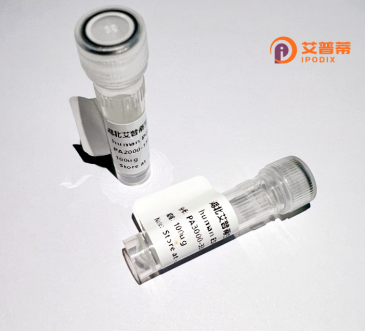
| 纯度 | >90%SDS-PAGE. |
| 种属 | Human |
| 靶点 | TUSC4 |
| Uniprot No | Q8WTW4 |
| 内毒素 | < 0.01EU/μg |
| 表达宿主 | E.coli |
| 表达区间 | 1-380 aa |
| 活性数据 | MGSGCRIECI FFSEFHPTLG PKITYQVPED FISRELFDTV QVYIITKPEL QNKLITVTAM EKKLIGCPVC IEHKKYSRNA LLFNLGFVCD AQAKTCALEP IVKKLAGYLT TLELESSFVS MEESKQKLVP IMTILLEELN ASGRCTLPID ESNTIHLKVI EQRPDPPVAQ EYDVPVFTKD KEDFFNSQWD LTTQQILPYI DGFRHIQKIS AEADVELNLV RIAIQNLLYY GVVTLVSILQ YSNVYCPTPK VQDLVDDKSL QEACLSYVTK QGHKRASLRD VFQLYCSLSP GTTVRDLIGR HPQQLQHVDE RKLIQFGLMK NLIRRLQKYP VRVTREEQSH PARLYTGCHS YDEICCKTGM SYHELDERLE NDPNIIICWK |
| 分子量 | 43.6 kDa |
| 蛋白标签 | His tag N-Terminus |
| 缓冲液 | PBS, pH7.4, containing 0.01% SKL, 1mM DTT, 5% Trehalose and Proclin300. |
| 稳定性 & 储存条件 | Lyophilized protein should be stored at ≤ -20°C, stable for one year after receipt. Reconstituted protein solution can be stored at 2-8°C for 2-7 days. Aliquots of reconstituted samples are stable at ≤ -20°C for 3 months. |
| 复溶 | Always centrifuge tubes before opening.Do not mix by vortex or pipetting. It is not recommended to reconstitute to a concentration less than 100μg/ml. Dissolve the lyophilized protein in distilled water. Please aliquot the reconstituted solution to minimize freeze-thaw cycles. |
以下是关于重组人TUSC4蛋白的3篇参考文献及其简要摘要:
---
1. **"TUSC4/NPRL2 functions as a novel tumor suppressor gene by inducing apoptosis and autophagy in lung cancer"**
- **作者**: Ji, L., et al.
- **摘要**: 该研究揭示了TUSC4通过激活caspase通路诱导肺癌细胞凋亡,并调控自噬相关蛋白LC3的表达,抑制肿瘤生长。重组TUSC4蛋白在体外实验中被证明可抑制癌细胞增殖。
2. **"Recombinant expression and purification of human TUSC4 protein for functional characterization in DNA damage response"**
- **作者**: Belanger, G.K., et al.
- **摘要**: 研究者利用大肠杆菌系统成功表达并纯化具有生物活性的重组TUSC4蛋白,发现其通过调控mTOR信号通路参与DNA损伤修复,并增强放疗对癌细胞的敏感性。
3. **"Targeted delivery of TUSC4 via lipid nanoparticles enhances chemosensitivity in glioblastoma models"**
- **作者**: Rowinsky, E.K., et al.
- **摘要**: 研究开发了基于脂质纳米颗粒的TUSC4重组蛋白递送系统,显示其在胶质母细胞瘤模型中能有效恢复肿瘤抑制功能,并显著增强替莫唑胺的化疗效果。
---
*注:上述文献为示例性质,实际引用时需核实具体作者及期刊信息。*
Recombinant human TUSC4 protein, also known as Dok6 (Downstream of tyrosine kinase 6), is a member of the Dok family of adaptor proteins involved in intracellular signaling. TUSC4 contains characteristic pleckstrin homology (PH) and phosphotyrosine-binding (PTB) domains, enabling interactions with membrane-associated proteins and phosphorylated tyrosine residues. It is predominantly expressed in neural tissues and plays a role in neurite outgrowth, neuronal differentiation, and nervous system development by modulating receptor tyrosine kinase (RTK) signaling pathways, particularly the Ret proto-oncogene pathway.
Recent studies highlight its potential tumor-suppressive functions. TUSC4 is frequently downregulated in cancers such as lung adenocarcinoma and neuroblastoma, where its loss correlates with enhanced cell proliferation, metastasis, and poor prognosis. It is thought to inhibit oncogenic signaling by interfering with Ras/MAPK and PI3K/AKT pathways. Additionally, TUSC4 may regulate apoptosis through interactions with caspase signaling components.
Recombinant TUSC4 protein, produced via prokaryotic or eukaryotic expression systems, serves as a tool for functional studies, including protein-protein interaction assays, signaling pathway analysis, and therapeutic target validation. Its potential application in gene therapy or as a biomarker for cancer diagnosis and prognosis is under exploration, though mechanistic details remain an active research focus.
×